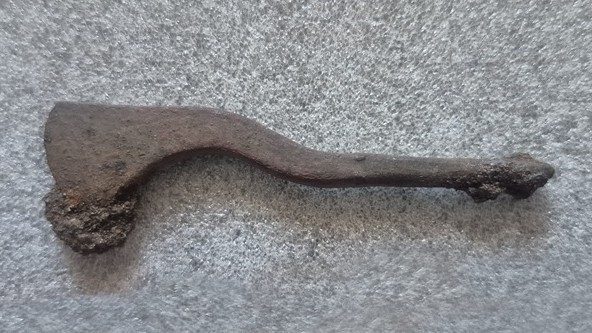Archaeologists digging at a remote settlement site in eastern Poland have made a startling discovery: an iron tool dating back 2,300 years, believed to be used for skull surgery by ancient Celts. This find not only sheds light on the medical practices of this fierce warrior culture but also adds another intriguing layer to our understanding of their sophisticated society and trade networks.
The hand-held artifact was unearthed at Łysa Góra, a site in Poland’s Mazovia region known for its remnants of Celtic occupation dating back to the 4th century BCE. Bartłomiej Kaczyński, an archaeologist from the State Archaeological Museum in Warsaw, confirmed that the tool’s construction techniques align with those used by Celtic blacksmiths at the time. Its design strongly suggests it was crafted specifically for trepanation—the ancient practice of drilling into skulls.
While seemingly barbaric by modern standards, trepanation was surprisingly widespread across various cultures from ancient Spain to Bolivia, practiced for at least 5,000 years until the early 19th century. Among the Celts, this surgical procedure appears to have served both practical and ritualistic purposes. They favored a technique involving scraping away portions of the skull rather than drilling holes, as documented in a 2007 study published in Neurosurgical Focus.
Despite evidence of trepanation tools found in Celtic graves elsewhere, Łysa Góra has not yet yielded any human remains showing signs of this procedure. This suggests that while the surgical knowledge existed within their community, its application may have been selective or tied to specific circumstances. The discovery itself is remarkable given the site’s geographical location—Łysa Góra marks the most northeastern Celtic settlement ever found in Europe.
Recent excavations at Łysa Góra have unearthed a trove of fascinating artifacts shedding light on the intricate lives of these Celtic inhabitants. In 2024, archaeologists uncovered a rare bronze helmet alongside numerous objects related to horseback riding and trade. The following year, a collection of brooches, spearheads, axes, and more metalwork linked to equestrian activities emerged from the earth.
This spring’s discovery of the trepanation scalpel further underscores the sophistication of this Celtic community. Its presence implies the existence of specialized individuals within their ranks who possessed both medical or ritual expertise and a blacksmith capable of forging such intricate tools.
Adding another layer to the puzzle, evidence suggests Łysa Góra was already fortified long before the Celts arrived in the 4th century BCE. Once they established themselves, however, the site quickly became a hub for trade, judging by the abundance of bronze and iron metallurgy products, unique imported goods, and fragmented amber objects discovered at the site. The prized material, highly valued across the Mediterranean world during this period, may have prompted the Celts to fortify Łysa Góra as a strategic point along the “amber trail.”
The discovery of the trepanation tool at Łysa Góra paints a complex picture of Celtic culture—a society known for its martial prowess yet deeply invested in advanced metalworking and possessing sophisticated medical practices interwoven with ritual beliefs.
